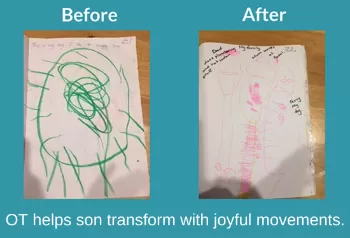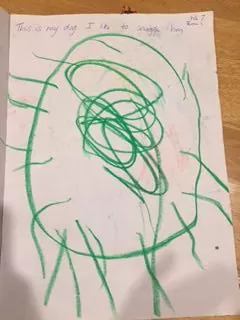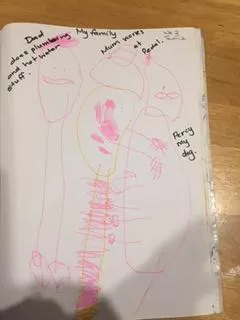Primitive Reflex Integration Case Studies
Preschool Boy Gains Focus, Sensory Regulation, Fine-Motor, and Confidence
Submitted by Nevanka St Clair, Occupational Therapist

| Before | After |
|---|---|
| Sensory issues: could only tolerate lukewarm baths | Can now tolerate warm baths |
| Would request calming music to be turned up to 100% to fall asleep and didn’t find this loud | Now considers loud music to be loud |
| Constantly seeking proprioceptive feedback through jumping, crashing, pushing legs on things, pulling hands and arms | Proprioceptive seeking has dropped significantly |
| Avoided drawing tasks, and mild delays were present | Drawing skills have improved dramatically |
| Had not yet chosen a dominant hand for writing | Although he still avoids crossing the midline and will swap hands due to this, he is now left-handed |
| Low self-esteem and a tendency to give up on things rather than keep trying | Self-esteem has improved |
| Mom was concerned about his ability to navigate the upcoming school year | Preschool has noticed a marked difference in all aspects of engagement in the classroom particularly his fine motor skills, his impulsivity, and confidence |
Al, age 4 years
Description of challenges before starting Rhythmic Movements and Reflex integration [from the Brain and Sensory Foundations course]:
- Difficulties crossing the midline
- Avoids drawing tasks and mild delays present
- Trouble listening and following instructions – can become defiant, cheeky, or impulsive
- Constantly seeking proprioceptive feedback through jumping, crashing, pushing legs on things, pulling hands and arms
- Difficult sitting still and very busy in his body
- Could only tolerate lukewarm baths
- Would request nighttime calming music to be turned up to 100% to fall asleep and didn’t find this loud
- Lots of tongue movement when completing fine motor tasks such as cutting and drawing
- Had not yet chosen a dominant hand for writing
- Low self-esteem and a tendency to give up on things rather than keep trying
Program chosen to use to help Al:
Al is my son and as an Occupational Therapist I observed that Al has some fine motor challenges as well as the sensory seeking behaviors. For past couple of years and I was concerned about how he was going to cope starting school next year.
I began with Rhythmic movements [from the Brain and Sensory Foundations course] for a period of about 1 month 5-7 days a week but only for 1-2 minutes total as this was all he could tolerate and would request to stop.
This went quite well for a while and he would enjoy doing these in time to the nursery rhyme of his choice. During this time, I started to integrate the Palmer and Babkin reflex [from the Brain and Sensory Foundations course] as I believed that this was impacting on his ability to complete fine motor tasks and enjoy them. The first time that I completed this with him he could only tolerate 1 minute or less of the integration activity, however afterwards he sat down and colored in for 20-30 minute which he had NEVER done before.
Not long after this I hurt my back, and everything pretty much stopped for a period of approximately 3 months or so. After a couple of months break whenever I suggested we try some rhythmical movements Al would groan and refuse. I began to get frustrated and was unsure how to proceed so decided to leave off from asking for a week or two and try again, but the whole process became a trial and something I was nagging about.
More recently I completed a 5 Step Balance Process for myself on the frustration of not being about to get Al to participate in the rhythmical movements and Reflex Integration. I then realized that I was not in Heart Connection and this had become a chore for both of us rather than a joy.
I started back in earnest with the program soon after completing the 5 step balance process. I again started with the Rhythmical Movements (RMs) 5-7 days and made them happy and silly by using different voices to sing the songs and keeping the heart connection. Al loved this.
I began doing this at bedtime, his dad also got involved to do the exercises at the same time and this helped as well. After completing the RM’s at bed time I also began again to work on the Babkin and Palmer Reflex. Al thought the integration activity we chose was hilarious and would request we do this activity over and over again. I began to start to integrate the ATNR [Asymmetrical Tonic Neck Reflex] as well. At first Al was only able to tolerate a little bit, after the RM, we then moved to other activities at other times during the day. We kept working at this for about three weeks and then moved up to moving into the actual isometric position of the ANTR. More recently we have also added the developmental movements [from the Brain and Sensory Foundations course] in sequence and have started lots of rolling and tumbling games. I chose these two reflexes to start with as when going through the list they were the reflexes that had the most ticked 'yes' for in the list of problems and also because they both developed earlier in utero. Moving forward I will begin to integrate some of the other reflexes and keep working on the ATNR as he still avoids crossing the midline.
Overall, the differences in Al have been quite amazing. He can now tolerate warm baths and finds loud music too loud. His proprioceptive seeking has dropped significantly and although he still avoids crossing the midline and will swap hands due to this he is left handed and his drawing skills have improved dramatically. This big change in drawing ability happened soon after starting to integrate the ATNR reflex.
A picture of his dog before ATNR Integration:

A Picture of his dog 7 - 8 weeks later after ATNR integration:

His preschool has also noticed a marked difference in all aspects of Al’s engagement in the classroom particularly his fine motor skills, his impulsivity and his confidence and self-esteem. There is still more work to be done and I will need to continue to work on integrating these reflexes as well as the other reflexes, but I am very excited with the results so far.
(Edited, emphasis added)
*Disclaimer: The activities in the Brain and Sensory Foundations curriculum make use of the natural processes of neuroplasticity and development that are innately wired in the design of human beings to promote maturity and function. These activities appear to calm, organize, and mature the neuro-sensory-motor systems just as we see in the healthy development of human infants. Individual results may vary, and we do not claim to offer a diagnosis or cure for any specific condition or disorder. The Brain and Sensory Foundations activities appear to improve overall functioning resulting in measurable improvements for a range of conditions as demonstrated in over 1800 case studies from participants.

